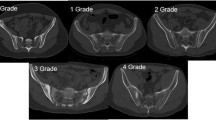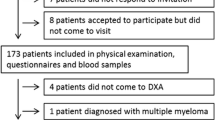Abstract
The objective of this study is to assess the prevalence and risk in patients with juvenile onset ankylosing spondylitis (JoAS) complicated with low bone mineral density (BMD). A total of 112 children and adolescents with JoAS were enrolled in the study. Bone mass was measured from the lumbar spine and the left proximal femur using dual-energy X-ray absorptiometry. According to the 2007 International Society of Clinical Densitometry definitions, a Z score of less than −2 was termed as “low BMD.” Stepwise regression analysis was used to investigate associations between low BMD and disease-related factors including gender, age, weight, height, body mass index, disease duration, HLA-B27 antigen, grades of sacroiliitis, Bath AS Disease Activity Index (BASDAI), Bath AS Functional Index (BASFI), patient global assessment (PGA), spine pain, erythrocyte sedimentation rate (ESR), and C-reactive protein (CRP). Low BMD was found in 18 (16.1 %) cases in at least one of the two measured regions. Lumbar spine BMD had negative correlations with BASDAI, BASFI, spine pain, ESR, and CRP (P < 0.05). Hip BMD significantly negatively correlated with BASDAI and PGA (P < 0.05). In conclusion, patients with JoAS are likely to develop low BMD, which may be related to high disease activity.
Similar content being viewed by others
Abbreviations
- aBMD:
-
Areal bone mineral density
- AS:
-
Ankylosing spondylitis
- ASAS:
-
Assessment in SpondyloArthritis International Society
- BASDAI:
-
Bath Ankylosing Spondylitis Disease Activity Index
- BASFI:
-
Bath Ankylosing Spondylitis Functional Index
- BMD:
-
Bone mineral density
- BMI:
-
Body mass index
- CRP:
-
C-reactive protein
- DXA:
-
Dual-energy X-ray absorptiometry
- ESR:
-
Erythrocyte sedimentation rate
- ISCD:
-
International Society of Clinical Densitometry
- JIA:
-
Juvenile idiopathic arthritis
- JoAS:
-
Juvenile onset ankylosing spondylitis
- mNY criteria:
-
Modified New York criteria
- PDC:
-
Pediatric Position Development Conference
- PGA:
-
Patient global assessment of disease activity
- SD:
-
Standard deviation
- SpA:
-
Spondyloarthritis
- VAS:
-
Visual analog scale
References
Karberg K, Zochling J, Sieper J et al (2005) Bone loss is detected more frequently in patients with ankylosing spondylitis with syndesmophytes. J Rheumatol 32(7):1290–1298
Sambrook PN, Geusens P (2012) The epidemiology of osteoporosis and fractures in ankylosing spondylitis. Ther Adv Musculoskelet Dis 4:287–292
Chen HA, Chen CH, Liao HT et al (2012) Clinical, functional, and radiographic differences among juvenile-onset, adult-onset, and late-onset ankylosing spondylitis. J Rheumatol 39(5):1013–1018
van der Weijden MA, van Denderen JC, Lems WF et al (2011) Low bone mineral density is related to male gender and decreased functional capacity in early spondylarthropathies. Clin Rheumatol 30:497–503
Stagi S, Masi L, Capannini S et al (2010) Cross-sectional and longitudinal evaluation of bone mass in children and young adults with juvenile idiopathic arthritis: the role of bone mass determinants in a large cohort of patients. J Rheumatol 37:1935–1943
van der Linden S, Valkenburg HA, Cats A (1984) Evaluation of diagnostic criteria for ankylosing spondylitis. A proposal for modification of the New York criteria. Arthritis Rheum 27:361–368
Rudwaleit M, van der Heijde D, Landewé R et al (2009) The development of Assessment of SpondyloArthritis International Society classification criteria for axial spondyloarthritis (part II): validation and final selection. Ann Rheum Dis 68:777–783
Tse SML, Laxer RM (2012) New advances in juvenile spondyloarthritis. Nat Rev Rheumatol 8(5):269–279
Reveille JD (2012) Genetic of spondyloarthritis-beyond the MHC. Nat Rev Rheumatol 8:296–304
Rauch F, Plotkin H, DiMeglio L et al (2008) Fracture prediction and the definition of osteoporosis in children and adolescents: the ISCD 2007 Pediatric Official Positions. J Clin Densitom 11:22–28
Garrett S, Jenkinson T, Kennedy LG et al (1994) A new approach to defining disease status in ankylosing spondylitis: the Bath Ankylosing Spondylitis Disease Activity Index. J Rheumatol 21:2286–2291
Calin A, Garrett S, Whitelock H et al (1994) A new approach to defining functional ability in ankylosing spondylitis: the development of the Bath Ankylosing Spondylitis Functional Index. J Rheumatol 21:2281–2285
Sambrook PN, Geusens P (2012) The epidemiology of osteoporosis and fractures in ankylosing spondylitis. Ther Adv Musculoskelet Dis 4(4):287–292
Feldtkeller E, Vosse D, Geusens P et al (2006) Prevalence and annual incidence of vertebral fractures in patients with ankylosing spondylitis. Rheumatol Int 26:234–239
Klingberg E, Lorentzon M, Mellström D et al (2012) Osteoporosis in ankylosing spondylitis—prevalence, risk factors and methods of assessment. Arthritis Res Ther 14:R108–R119
Huang CH, Wei JC, Hung PS et al (2011) Osteoprotegerin genetic polymorphisms and age of symptom onset in ankylosing spondylitis. Rheumatology (Oxf) 50:359–365
Taylan A, Sari I, Akinci B et al (2012) Biomarkers and cytokines of bone turnover: extensive evaluation in a cohort of patients with ankylosing spondylitis. BMC Musculoskelet Disord 13:191–197
Grazio S, Kusić Z, Cvijetić S et al (2012) Relationship of bone mineral density with disease activity and functional ability in patients with ankylosing spondylitis: a cross-sectional study. Rheumatol Int 32:2801–2808
Aydin T, Karacan I, Demir SE et al (2005) Bone loss in males with ankylosing spondylitis: its relation to sex hormone levels. Clin Endocrinol (Oxf) 63:467–469
Arends S, Spoorenberg A, Bruyn GA et al (2011) The relation between bone mineral density, bone turnover markers, and vitamin D status in ankylosing spondylitis patients with active disease: a cross-sectional analysis. Osteoporos Int 22:1431–1439
Acknowledgments
This study was supported in part by Grants from the National Natural Science Foundation of China (number 81172782).
Human and Animal Rights and Informed Consent
All procedures in the study were in accordance with the ethical standards of the responsible committee on human experimentation (institutional and national) and with the Helsinki Declaration of 1975, as revised in 2008 (5). Informed consent was obtained from all patients for being included in the study.
Author information
Authors and Affiliations
Corresponding author
Additional information
No disclosures.
Rights and permissions
About this article
Cite this article
Bao, J., Chen, Y. & Bao, YX. Prevalence and Risk Factors of Low Bone Mineral Density in Juvenile Onset Ankylosing Spondylitis. Calcif Tissue Int 95, 108–111 (2014). https://doi.org/10.1007/s00223-014-9867-2
Received:
Accepted:
Published:
Issue Date:
DOI: https://doi.org/10.1007/s00223-014-9867-2




